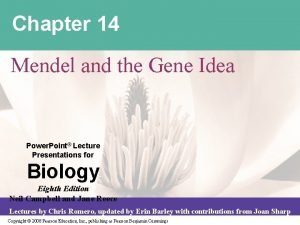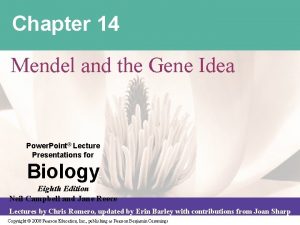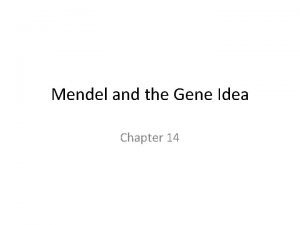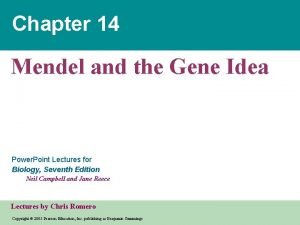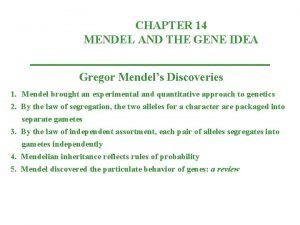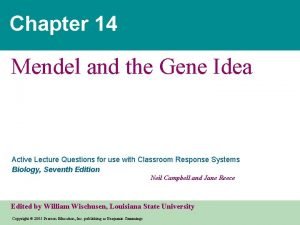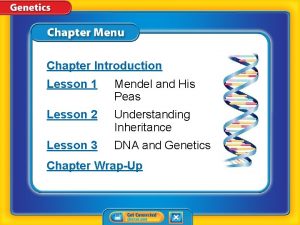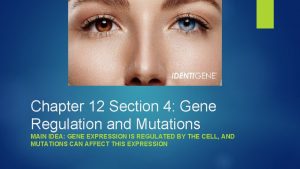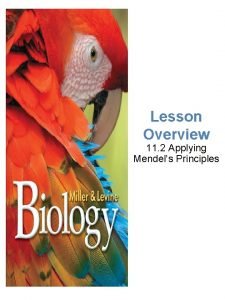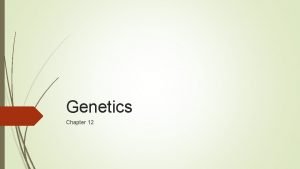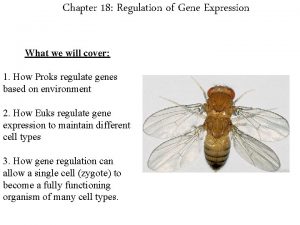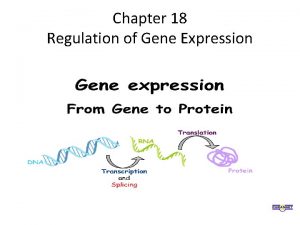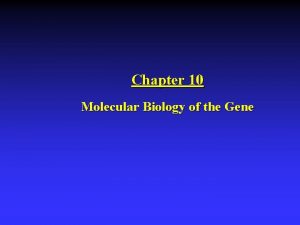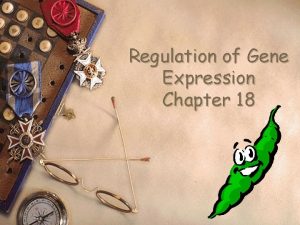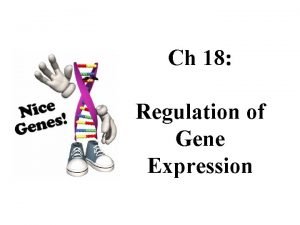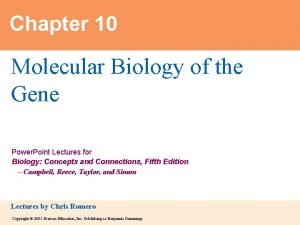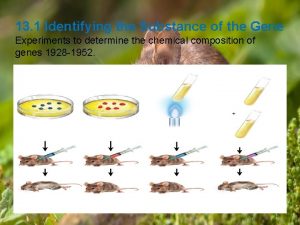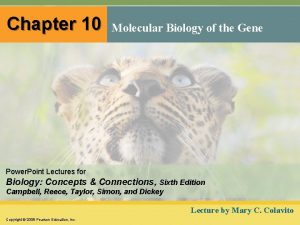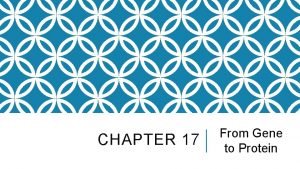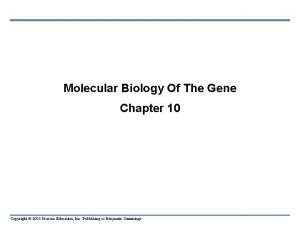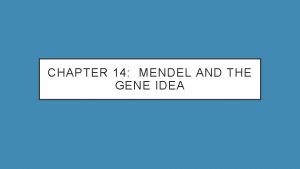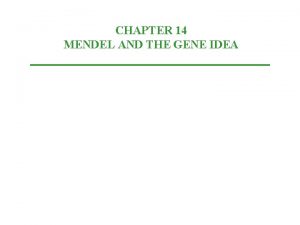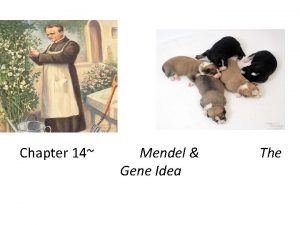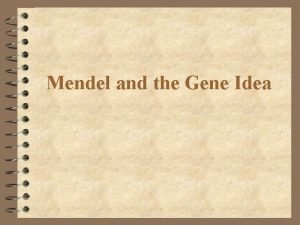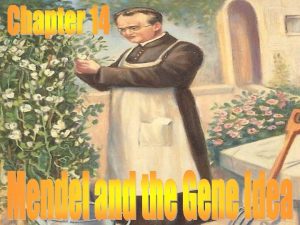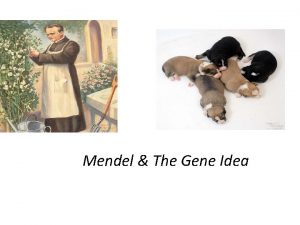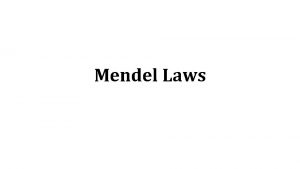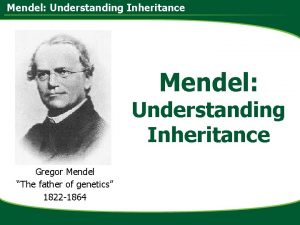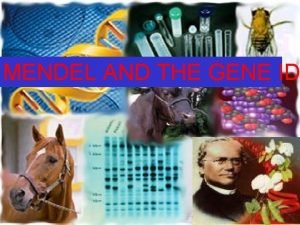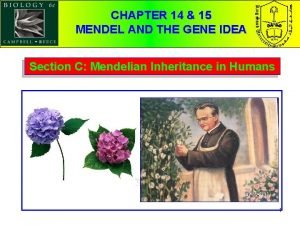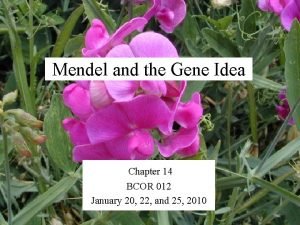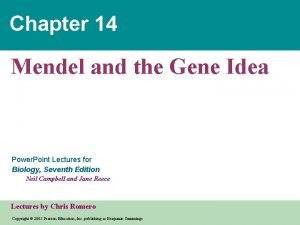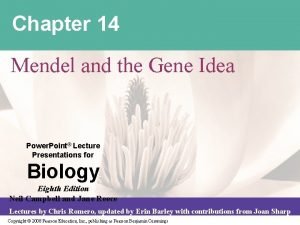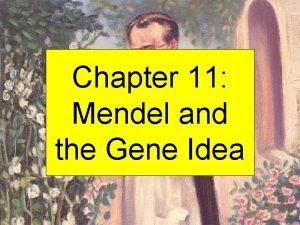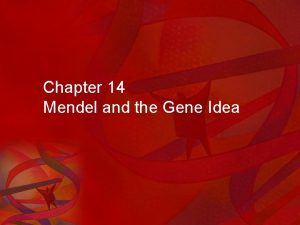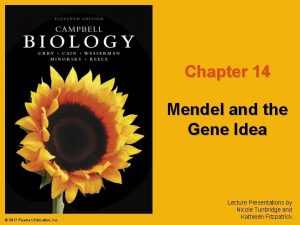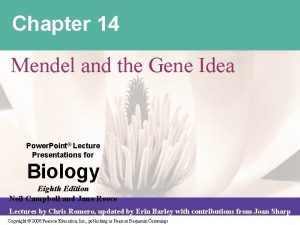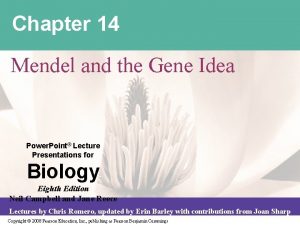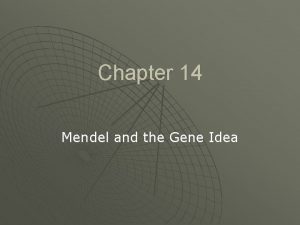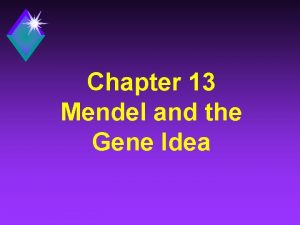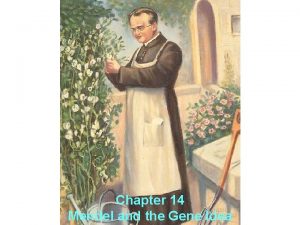Mendel and the Gene Idea Chapter 14 What
























































- Slides: 56

Mendel and the Gene Idea Chapter 14

What genetic principles account for the transmission of traits from parents to offspring? 1) “Blending” hypothesis: Paint 2) “Particulate” hypothesis: Deck of Cards • The gene idea states that parents pass on discrete heritable units called genes

Gregor Mendel • Used the scientific approach to identify two laws of inheritance • Discovered the basic principles of heredity by breeding garden peas – Why Peas? • Available in a variety of colors – Color is an example of a character, a heritable feature that varies among individuals » Each variant for a color is called a trait • Control Plant Mating


• In a typical breeding experiment Mendel mated two contrasting, true-breeding varieties, a process called hybridization. – The true-breeding parents are called the P generation • The hybrid offspring of the P generation are called the F 1 generation – When F 1 individuals self-pollinate the F 2 generation is produced

The Law of Segregation • When Mendel crossed contrasting, truebreeding white and purple flowered pea plants all of the offspring were purple – When Mendel crossed the F 1 plants many of the plants had purple flowers, but some had white flowers • Mendel discovered a ratio of about three to one, purple to white flowers, in the F 2 generation


Mendel’s Observations • Mendel reasoned that in the F 1 plants, only the purple flower factor was affecting flower color in these hybrids – Purple flower color was dominant, and white flower color was recessive • Mendel observed the same pattern in many other pea plant characters


Mendel’s Model • Mendel developed a hypothesis to explain the 3: 1 inheritance pattern that he observed among the F 2 offspring – Four related concepts make up this model

First Concept • Alternative versions of genes – Account for variations in inherited characters, which are now called alleles

Second Concept • For each character: – An organism inherits two alleles, one from each parent – A genetic locus is actually represented twice

Third Concept • If the two alleles at a locus differ: – Then one, the dominant allele, determines the organism’s appearance – The other allele, the recessive allele, has no noticeable effect on the organism’s appearance

Forth Concept • The law of segregation – The two alleles for a heritable character separate (segregate) during gamete formation and end up in different gametes


Useful Genetic Vocabulary • An organism that is homozygous for a particular gene – Has a pair of identical alleles for that gene – Exhibits true-breeding for that character • An organism that is heterozygous for a particular gene – Has a pair of alleles that are different for that gene


The Testcross • In pea plants with purple flowers, the genotype is not immediately obvious. – A testcross allows us to determine the genotype of an organism with the dominant phenotype, but unknown genotype • Crosses an individual with the dominant phenotype with an individual that is homozygous recessive for a trait.


The Law of Independent Assortment • Mendel derived the law of segregation by following a single trait. – The F 1 offspring produced in this cross were monohybrids, heterozygous for one character • Mendel identified his second law of inheritance by following two characters at the same time – Crossing two, true-breeding parents differing in two characters produces dihybrids in the F 1 generation, heterozygous for both characters

Dihybrid Cross • A dihybrid cross illustrates the inheritance of two characters – Produces four phenotypes in the F 2 generation


Practice Question # 1 • A pea plant heterozygous for inflated pods (Ii) is crossed with a plant homozygous for constricted pods (ii). Draw a Punnett square for this cross.

Practice Question # 2 • Pea plants heterozygous for flower position and stem length (Aa. Tt) are allowed to self-pollinate, and 400 of the resulting seeds are planted. Draw a Punnett square for this cross. How many offspring would be predicted to have terminal flowers and be dwarf?

The Law of Probability • The laws of probability govern Mendelian inheritance. – Mendel’s laws of segregation and independent assortment reflect the rules of probability: • The Multiplication Rule • The Rule of Addition

The Multiplication and Addition Rules Applied to Monohybrid Crosses • The multiplication rule: “independent events in sequence” – States that the probability that two or more independent events will occur together is the product of their individual probabilities. • The rule of addition: “mutually exclusive events” *or – States that the probability that any one of two or more exclusive events will occur is calculated by adding together their individual probabilities.

What is the probability of flipping 4 coins and getting heads each time? What is the probability of rolling “snake eyes”?

Multiplication 1. In a cross between pea plants that are heterozygous for purple flower color (Pp), what is the probability that the offspring will be homozygous recessive? 2. In a cross between Aa. Bb. Cc x Aa. BBCC what is the probablity that the offspring will be Aa. Bb. CC?

Addition 1. What are the odds of getting a heads or a tails when flipping a coin? 2. Rolling a two or a five on a six-sided dice. 3. Picking a five or a heart out of a deck of 52 playing cards.

Addition 1. In a cross between pea plants that are heterozygous for purple flower color (Pp), what is the probability of the offspring being a heterozygote? 2. In a cross between Aa. Bb. Cc x Aa. BBCC what is the probability that the offspring will be AABb. Cc or AABBCC?

Extending Mendelian Genetics for a Single Gene • Inheritance patterns are often more complex than predicted by simple Mendelian genetics. – The relationship between genotype and phenotype is rarely simple.

The Spectrum of Dominance • Complete Dominance occurs when the phenotypes of the heterozygote and dominant homozygote are identical. • In Codominance, two dominant alleles affect the phenotype in separate, distinguishable ways. – The human blood group AB is an example of codominance. • In Incomplete Dominance, the phenotype of F 1 hybrids is somewhere between the phenotypes of the two parental varieties.


The Relationship Between Dominance and Phenotype • Dominant and recessive alleles do not really “interact”. – Lead to synthesis of different proteins or enzymes that produce a phenotype • Dominant alleles are not necessarily more common in populations than recessive alleles.

Tay Sachs Disease • An inherited disorder, in which the brain cells of a child cannot metabolize certain lipids because hexosaminidase A, or hex A (enzyme) does not work correctly. • An accumulation of lipids > seizures, blindness, and degeneration of motor and mental performance. • Average Life Expectancy: 2 to 4 years old • Nathan's Story: You. Tube Video



Tay Sachs Disease • Children who are homozygous for the Tay Sachs allele have the disease, thus the Tay Sachs allele qualifies as recessive. (Organism Level) • However, the activity level of the lipidmetabolizing enzyme in heterozygotes is intermediate. Incomplete dominance. (Biochemical Level) • Heterozygotes produce equal #s of normal and dysfunctional enzyme molecules. Codominance. (Molecular Level)

Multiple Alleles • Most genes exist in populations in more than two allelic forms • The ABO blood group in humans is determined by multiple alleles.

Pleiotrophy • Is a property of a gene has multiple phenotypic effects. – Most genes are pleiotrophic. • Pleiotrophic alleles are responsible for the multiple symptoms associated with certain hereditary diseases in humans. – Cystic Fibrosis – Sickle-Cell Disease

Extending Mendelian Genetics for Two or More Genes • Some traits may be determined by two or more genes – In Epistasis, a gene at one locus alters the phenotypic expression of a gene at a second locus. • The gene for pigment deposition is said to be epistatic to the gene that codes for black or brown pigment.


Polygenic Inheritance • Many human characters vary in the population along a continuum and are called quantitative characters. – Quantitative variation usually indicates polygenic inheritance. • An additive effect of two or more genes on a single phenotype


Nature and Nurture: The Environmental Impact on Phenotype • Another departure from simple Mendelian genetics arises when the phenotype for a character depends on environment as well as on genotype – The norm of reaction is the phenotypic range of a particular genotype that is influenced by the environment • Multifactorial Characters are those that are influenced by both genetic and environmental factors

Integrating a Mendelian View of Heredity and Variation • An organism’s phenotype includes its physical appearance, internal anatomy, physiology, and behavior – Reflects its overall genotype and unique environmental history • Even in more complex inheritance patterns Mendel’s fundamental laws of segregation and independent assortment still apply

Pedigrees • Many human traits follow Mendelian patterns of inheritance – Although humans are not convenient subjects for genetic research, the study of human genetics continues to advance • A Pedigree is a family tree that describes the interrelationships of parents and children across generations

• Inheritance patterns of particular traits can be traced and described using pedigrees

Recessively Inherited Disorders • Many genetic disorders are inherited in a recessive manner – Recessively inherited disorders show up only in individuals homozygous for the allele • Carriers are heterozygous individuals who carry the recessive allele but are phenotypically normal

Cystic Fibrosis • Symptoms of cystic fibrosis include: – Mucus buildup in the some internal organs – Abnormal absorption of nutrients in the small intestine

Sickle-Cell Disease • Sickle-cell disease: – Affects one out of 400 African-Americans – Is caused by the substitution of a single amino acid in the hemoglobin protein in red blood cells • Symptoms include physical weakness, pain, organ damage, and even paralysis

Mating of Close Relatives • Matings between relatives: – Can increase the probability of the appearance of a genetic disease – Are called Consanguineous Matings

Dominantly Inherited Disorders • Some human disorders are due to dominant alleles – One example is Achondroplasia which is a form of dwarfism that is lethal when homozygous for the dominant allele – Huntington’s Disease is a degenerative disease of the nervous system • Has no obvious phenotypic effects until about 35 to 40 years of age

Multifactorial Disorders • Many human diseases have both genetic and environment components – Examples include Heart disease and cancer • Little is understood about the genetic contributions to most multifactorial diseases. – The best strategy is to educate people about he importance of environmental factors and to promote healthful behavior.

• • • • • 3. A. 3 a Rules of probability can be applied to analyze passage of single gene traits from parent to offspring 3. A. 3 b Segregation and independent assortment of chromosomes result in genetic variation 1. Segregation and independent assortment can be applied to genes that are on different chromosomes 2. Genes that are adjacent and close to each other on the same chromosome tend to move as a unit; the probability that they will segregate as a unit is a function of the distance between them 3. The pattern of inheritance (monohybrid, dihybrid, sex-linked, and genes linked on the same homologous chromosome) can often be predicted from data that gives the parent genotype/phenotype and/or the offspring phenotypes/genotypes 3. A. 3 c Certain human genetic disorders can be attributed to the inheritance of single gene traits or specific chromosomal changes, such as nondisjunction (for example, sickle cell anemia, tay-sachs disease, huntington’s disease, x-linked color blindess, trisomy 21/down syndrome, klinefelter’s syndrome) 3. A. 3 d Many ethical, social, and medical issues surround human genetic disorders (for example, reproduction issues, civic issues such as ownership of genetic information, privacy, historical contexts, etc. ) 3. A. 4 a Many traits are the product of multiple genes and/or physiological processes. Patterns of inheritance of many traits do not follow ratios predicted by Mendel’s laws and can be identified by quantitative analysis, where observed phenotypic ratios statistically differ from the predicted ratios (do NOT need to know epistasis or pleiotropy) heterozygous advantage). Selection results in evolutionary change.

• 3. A. 4 b Some traits are determined by genes on sex chromosomes (for example, sex-linked genes reside on sex chromosomes (x in humans); in mammals and flies, the Y chromosome is very small and carries few genes; some traits are sex limited, and expression depends on the sex of the individual, such as milk production in female mammals and pattern baldness in males • 3. C. 1 a Alterations in a DNA sequence can lead to changes in the type or amount of the protein produced and the consequent phenotype. DNA mutations can be positive, negative or neutral based on the effect or the lack of effect they have on the resulting nucleic acid or protein and the phenotypes that are conferred by the protein • 3. C. 1 b Errors in DNA replication or DNA repair mechanisms, and external factors, including radiation and reactive chemicals, can cause random changes, e. g. , mutations in the DNA. Whether or not a mutation is detrimental, beneficial or neutral depends on the environmental context. Mutations are the primary source of genetic variation. • • 3. C. 1 c Errors in mitosis can result in change in phenotype 1. Changes in chromosome number often result in new phenotypes, including sterility caused by triploidy and increased vigor of other polyploids. • 2. Changes in chromosome number often result in human disorders with developmental limitations, including Trisomy 21 (Down syndrome) and XO (Turner syndrome). • 3. C. 1 d Changes in genotype may affect phenotypes that are subject to natural selection. Genetic changes that enhance survival and reproduction can be selected by environmental conditions (for example, antibiotic resistance mutations, pesticide resistance mutations, sickle cell disorder and
 Mendel and the gene idea chapter 14
Mendel and the gene idea chapter 14 Chapter 14 mendel and the gene idea
Chapter 14 mendel and the gene idea Chapter 14 mendel and the gene idea
Chapter 14 mendel and the gene idea Chapter 14 mendel and the gene idea
Chapter 14 mendel and the gene idea Chapter 14 mendel and the gene idea
Chapter 14 mendel and the gene idea Chapter 14 mendel and the gene idea
Chapter 14 mendel and the gene idea Chapter 17: from gene to protein
Chapter 17: from gene to protein Gene by gene test results
Gene by gene test results It reveals the main or central idea of a paragraph
It reveals the main or central idea of a paragraph Main idea and controlling idea
Main idea and controlling idea Theme and topic difference
Theme and topic difference Topic sentence supporting sentences concluding sentence
Topic sentence supporting sentences concluding sentence Example of main idea
Example of main idea Chapter 5 genetics lesson 1 mendel and his peas
Chapter 5 genetics lesson 1 mendel and his peas Homiletical idea
Homiletical idea Contoh ayat penanda organisasi
Contoh ayat penanda organisasi Section 4 gene regulation and mutation
Section 4 gene regulation and mutation Sexual reproduction and genetics section 1 meiosis
Sexual reproduction and genetics section 1 meiosis Applying mendel's principles
Applying mendel's principles Chapter 12 lesson 1 the work of gregor mendel
Chapter 12 lesson 1 the work of gregor mendel Chapter 12 lesson 1 the work of gregor mendel
Chapter 12 lesson 1 the work of gregor mendel 11.2 applying mendel's principles
11.2 applying mendel's principles Chapter 11 the work of gregor mendel
Chapter 11 the work of gregor mendel Chapter 18 regulation of gene expression
Chapter 18 regulation of gene expression Chapter 18 regulation of gene expression
Chapter 18 regulation of gene expression Molecular biology of the gene chapter 10
Molecular biology of the gene chapter 10 Chapter 18 regulation of gene expression
Chapter 18 regulation of gene expression Chapter 18
Chapter 18 Chapter 10: molecular biology of the gene
Chapter 10: molecular biology of the gene Chapter 13 lesson 1 identifying the substance of the gene
Chapter 13 lesson 1 identifying the substance of the gene Chapter 17 from gene to protein
Chapter 17 from gene to protein Chapter 10 molecular biology of the gene
Chapter 10 molecular biology of the gene Chapter 17 from gene to protein
Chapter 17 from gene to protein Hershey and chase
Hershey and chase Hát kết hợp bộ gõ cơ thể
Hát kết hợp bộ gõ cơ thể Lp html
Lp html Bổ thể
Bổ thể Tỉ lệ cơ thể trẻ em
Tỉ lệ cơ thể trẻ em Gấu đi như thế nào
Gấu đi như thế nào Chụp phim tư thế worms-breton
Chụp phim tư thế worms-breton Hát lên người ơi alleluia
Hát lên người ơi alleluia Các môn thể thao bắt đầu bằng từ đua
Các môn thể thao bắt đầu bằng từ đua Thế nào là hệ số cao nhất
Thế nào là hệ số cao nhất Các châu lục và đại dương trên thế giới
Các châu lục và đại dương trên thế giới Công của trọng lực
Công của trọng lực Trời xanh đây là của chúng ta thể thơ
Trời xanh đây là của chúng ta thể thơ Cách giải mật thư tọa độ
Cách giải mật thư tọa độ Làm thế nào để 102-1=99
Làm thế nào để 102-1=99 độ dài liên kết
độ dài liên kết Các châu lục và đại dương trên thế giới
Các châu lục và đại dương trên thế giới Thơ thất ngôn tứ tuyệt đường luật
Thơ thất ngôn tứ tuyệt đường luật Quá trình desamine hóa có thể tạo ra
Quá trình desamine hóa có thể tạo ra Một số thể thơ truyền thống
Một số thể thơ truyền thống Bàn tay mà dây bẩn
Bàn tay mà dây bẩn Vẽ hình chiếu vuông góc của vật thể sau
Vẽ hình chiếu vuông góc của vật thể sau Thế nào là sự mỏi cơ
Thế nào là sự mỏi cơ đặc điểm cơ thể của người tối cổ
đặc điểm cơ thể của người tối cổ
